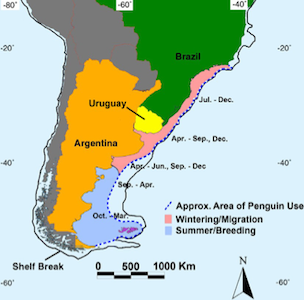
Conservation of migratory Magellanic penguins requires marine zoning.
David L. Stokes, P. Dee Boersma, Javier Lopez de Casenave, Pablo García-Borboroglu
Biological Conservation 170:151-161. 2014.
Abstract
Conservation of migratory species requires an understanding of their migration path and pattern. We used band returns and satellite tracking to characterize the seasonal migration of Magellanic penguins breeding in southern Argentina, with the purpose of identifying an effective conservation approach for this species. Band returns show these penguins migrate annually to the coastal waters of northern Argentina, Uruguay, and southern Brazil, an average one-way distance of approximately 2000 km, and a modal distance of 2300–2400 km. Satellite data indicate that the penguins follow a migration corridor within 250 km of shore. Mean migration distance varied among years. Juveniles migrated farther on average than older birds, although migration distance of different age classes overlapped substantially. Mortality rates during migration were higher among younger birds, and juvenile mortality rate during migration was inversely correlated with cohort survival, indicating that mortality during migration is an important determinant of population recruitment. A minimum of 13% of the migration-period mortality we recorded resulted from fisheries bycatch and oil pollution. Because of the penguin’s mode of travel (swimming at or near the surface), the large spatial extent of its migration, and the intensity of human use of the area, effective conservation through conventional coastal marine reserves is unlikely. Marine zoning is an alternative that could provide the spatial scale and flexibility necessary to accommodate both penguin migration and human activities. As the waters traversed by Magellanic penguins are among the most threatened in Latin America, zoning for protection of this wide-ranging and charismatic species can also protect regional biodiversity.